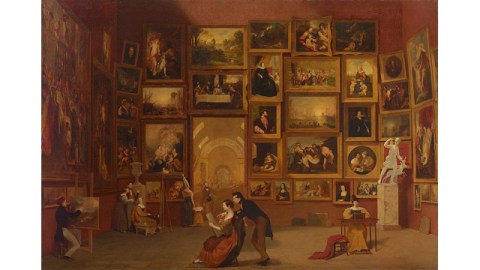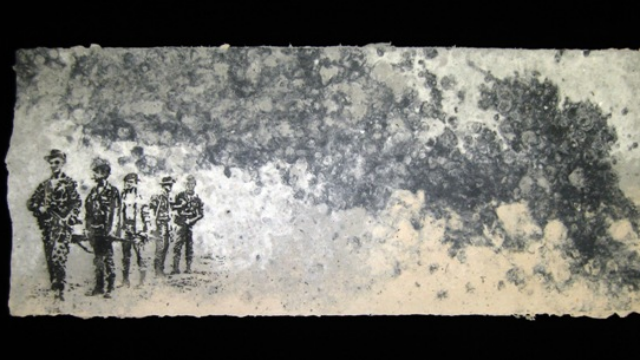How Samuel Morse Telegraphed a New Direction for American Art

When you hear the name Samuel F. B. Morse you most likely think about Morse code or the telegraph. In reality, Morse only co-invented the code that bears his name and simply contributed to the already developing technology of the telegraph. But nobody can take any credit away from Morse for his first love of and forgotten gift for painting. In A New Look: Samuel F. B. Morse’s Gallery of the Louvre, which runs at the National Gallery of Art, Washington, DC, through July 8, 2012, Morse’s talents as painter and teacher of painting are fully on display with the newly restored painting Gallery of the Louvre (shown above). In this exhibit we see just how Morse telegraphed a new direction for American art away from the unappealing alternatives of slavish devotion to the Western canon or awkward backwoods folk art and towards an appropriation of the best in art history tailored to fit the newly rising American nation.
Morse visited the Louvre briefly in 1830 during his three-year Grand Tour of Europe. Enthralled by the grand space of the Louvre’s Salon Carré, Morse decided to paint a portrait of the room as both a tribute to the masters collected there and as an educational tool for his fellow Americans back home. Returning a year later, Morse found the Salon Carré stripped of Old Masters and, instead, filled with contemporary French painters. Undaunted, Morse created the fiction that is the Gallery of the Louvre and curated an exhibition to suit his taste and that of his mentor, Washington Allston. Titian, Veronese, Caravaggio, Rubens, Van Dyck, Correggio, and Watteau, among others, all make the cut in miniature reproductions by Morse. Play a little “Where’s Waldo?” and you’ll find Leonardo da Vinci’s Mona Lisa lurking among the masterpieces—an acknowledged wonder already by the early 19th century, but not yet the megastar it would become. Morse published Descriptive Catalogue of the Pictures…from the Most Celebrated Masters, Copied into the “Gallery of the Louvre” in 1833 as a written key to his crash course in the Western tradition, emphasizing the educational goals of the painting itself.
In addition to flooding the walls of his fictional, personal salon with his art heroes, Morse peopled the floor with his circle of closest friends and family. In the center, Morse paints himself looking over the shoulder of his daughter Susan as she copies from the masters. In the rear, almost directly behind Morse and Susan, American sculptor Horatio Greenough, one of Morse’s Parisian roommates, appears beside an unidentified woman and daughter roaming the galleries. Richard W. Habersham, Morse’s other roommate in Paris, sits in the left foreground copying an unidentified landscape. The three roommates certainly debated who would hang in their dream galleries from the Louvre and those discussions helped shape Morse’s painting, so Morse put them there physically as well as in spirit.
Perhaps even more importantly, Morse places his friend, American novelist James Fenimore Cooper in the far, left corner with his wife and daughter. Cooper and his wife stand behind their daughter at the easel. In his Leatherstocking Tales, Cooper took the noble savage of European romanticism and fashioned a uniquely American equivalent in Natty Bumppo. Cooper and Washington Irving took European models and forged the earliest American literature up to the 1830s. After the 1830s, during the American Renaissance, Poe, Hawthorne, Melville, Whitman, and others took up the challenge further, extending and transforming the Western tradition in literature into an American idiom. Although Thomas Cole had begun a nascent American art movement that would become the Hudson River School, Morse hoped to do for painting what Cooper had done for American literature, namely not shy away from the European tradition, but to embrace it fully and make it their own, make it American. Cooper’s presence in the painting serves as a reminder of (and a challenge to match) what could be accomplished.
The final figure, the woman painting at the right, remains a mystery. Some scholars believe her to be a “Miss Joreter,” a young woman whom Morse taught in the Louvre. More romantically minded critics, however, entertain the possibility that it is Lucretia, Morse’s dearly departed wife brought back from the dead. In 1825, Lucretia fell gravely ill while Morse was away in New York painting the Marquis de Lafayette. By the time Morse received word and rushed to her side, Lucretia had already been buried. Frustrated by the limited communications of the time, Morse vowed to pursue new technology to save others from the agony of never getting to say goodbye. I like to think of Morse’s Gallery of the Louvre as his way of saying goodbye to Lucretia—a grand gesture to show her the great things she still inspired him to pursue. It’s entirely possible that we’re looking at Miss Joreter, but in the fantasy world of the Gallery of the Louvre built by Morse, I doubt it. Gallery of the Louvre is a love letter to art itself, so why can’t it also be a last love letter to the love of Morse’s life?
Morse, alas, turned his considerable energies to the telegraph shortly after completing his Louvre-based project. Instead of just communicating the new direction of American art, Morse decided to communicate the new direction of America itself as the spearhead of globalization in the 19th, 20th, and 21st centuries. A New Look: Samuel F. B. Morse’s Gallery of the Louvre reminds us of how Morse dreamed big for American art and tried to pass on that dream to a whole nation’s art. For a country and world facing a downturn, looking up at the big dreams of the past might be the first step in dreaming big ourselves.
[Image:Samuel F. B. Morse, Gallery of the Louvre, 1831–1833, oil on canvas, Terra Foundation for American Art, Daniel J. Terra Collection.]
[Many thanks to the National Gallery of Art, Washington, DC, for the image above and other press materials for A New Look: Samuel F. B. Morse’s Gallery of the Louvre, which runs through July 8, 2012.]




